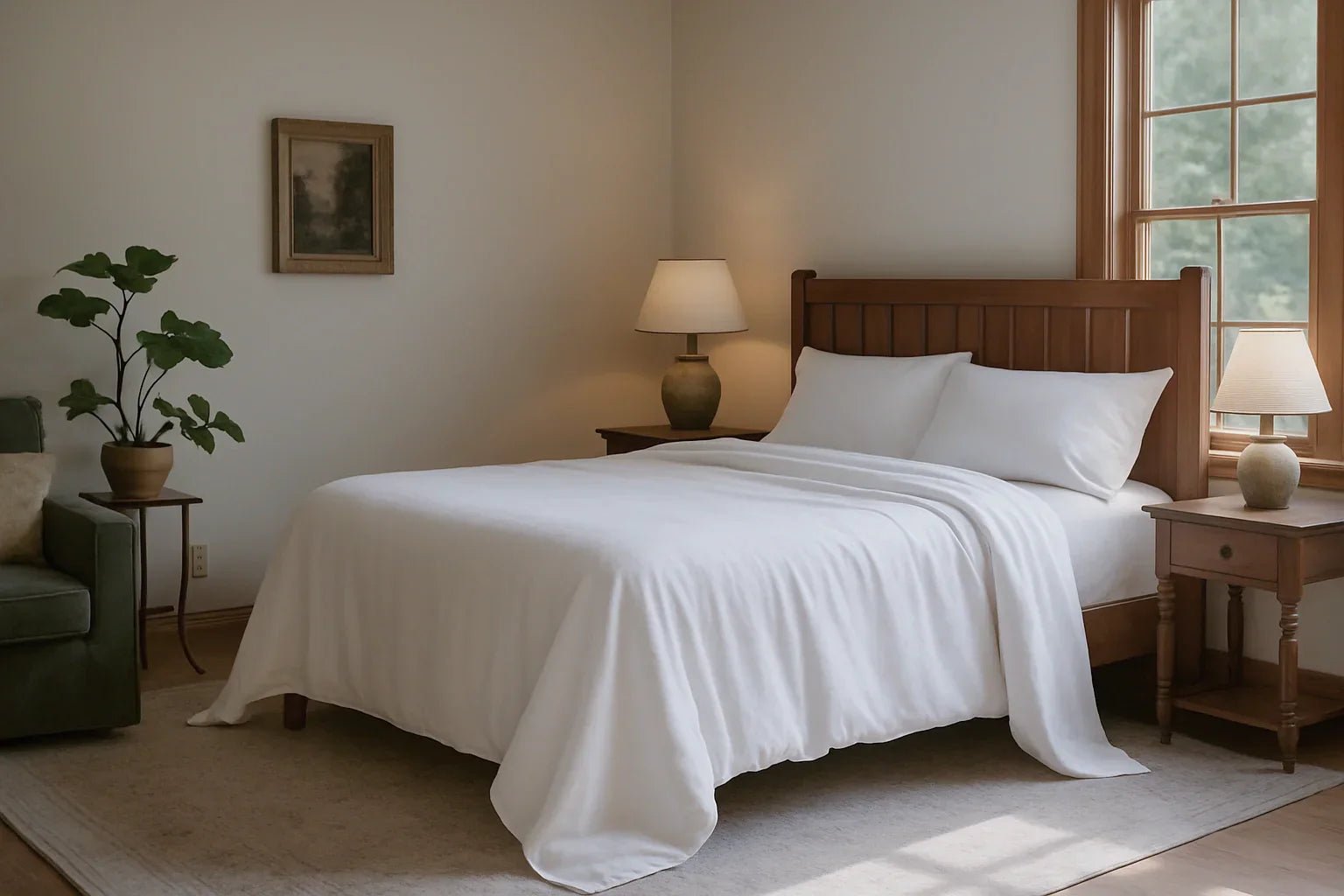Table of Contents
- Introduction: The Bedding Revolution
- Understanding Sheet Materials: Cotton vs Microfiber
- The Problem: Why Traditional Cotton Sheets Fall Short
- The Solution: Microfiber's Revolutionary Advantages
- The Elasticity Breakthrough: How GOKOTTA Solved the Fitted Sheet Problem
- The Durability Revolution: GOKOTTA's Precision Stitching Advantage
- GOKOTTA's Complete Microfiber Excellence: Beyond the Basics
- Comprehensive Comparison: Microfiber vs Cotton
- Who Benefits Most from Microfiber Sheets?
- What Users Are Saying: Real-World Experiences
- Caring for Your Microfiber Sheets: Maximizing Longevity
- Conclusion: Making the Smart Bedding Investment
Introduction: The Bedding Revolution
The landscape of luxury bedding is undergoing a quiet revolution. For generations, cotton reigned supreme as the unquestioned monarch of premium sheets. Egyptian cotton, in particular, has long been the gold standard against which all bedding was measured. Yet, in recent years, this comfortable certainty has been disrupted by the emergence of advanced microfiber technologies that challenge cotton's dominance not through imitation, but through innovation.
The fundamental question facing today's discerning consumers is no longer simply "Which cotton sheets should I buy?" but rather "Are microfiber sheets actually better than cotton?" This paradigm shift reflects a deeper evolution in how we approach bedroom comfort and bedding performance.
GOKOTTA has emerged as a leader in this transformation, with their premium microfiber sheet sets consistently earning top ratings on Amazon. Their approach isn't merely to create a synthetic alternative to cotton but to engineer solutions to cotton's inherent limitations—addressing problems that have been accepted as unavoidable trade-offs for generations.
This exploration delves into the science and experience of both materials, with special attention to the revolutionary engineering advancements that make modern microfiber not just different from cotton, but potentially superior for many sleepers.
Understanding Sheet Materials: Cotton vs Microfiber
To appreciate the significance of recent innovations, we must first understand the fundamental differences between these competing materials.
Cotton sheets derive from natural plant fibers harvested from cotton bolls. The quality spectrum ranges from standard short-staple cotton to premium long-staple varieties like Egyptian and Pima cotton. Quality is traditionally measured by thread count—the number of threads woven into a square inch of fabric—though this metric has limitations and can be manipulated through marketing tactics.
Microfiber, by contrast, represents advanced textile engineering. These sheets are crafted from ultra-fine synthetic fibers (primarily polyester, sometimes blended with nylon or other polymers) that are significantly thinner than human hair—often less than one denier in diameter. This extraordinary fineness creates a fabric with distinctive properties measured by GSM (grams per square meter) rather than thread count.
The manufacturing processes for these materials also differ significantly. Cotton undergoes spinning, weaving, and various treatments to achieve desired characteristics. Microfiber production involves extrusion of polymers into microscopic fibers followed by precision weaving and specialized finishing techniques like brushing to achieve specific performance characteristics.
These fundamental material differences create distinct experiences for users—differences that go far beyond the simplistic "natural versus synthetic" dichotomy often emphasized in less nuanced comparisons.
The Problem: Why Traditional Cotton Sheets Fall Short
The limitations of cotton sheets have been so normalized that many consumers simply accept them as inevitable aspects of bedding ownership rather than design flaws to be solved. Yet when examined critically, these shortcomings represent significant opportunities for improvement:
The Elasticity Dilemma: Traditional fitted sheets employ single-layer elastic bands that quickly lose tension, often beginning to slacken after just 3-6 months of regular use. This degradation results in corners that continually pop off mattresses, creating frustrating middle-of-the-night disruptions and perpetual re-tucking requirements.
The Durability Challenge: Conventional hemming techniques used in cotton sheet manufacturing typically employ only 2-3 stitches per centimeter. This sparse stitching becomes a predictable failure point, particularly at high-stress areas like corners and edges where the fabric experiences the most tension during use and laundering.
The Maintenance Burden: Cotton's natural propensity for wrinkling necessitates either acceptance of a perpetually rumpled aesthetic or time-consuming ironing rituals. Additionally, the material's porous structure makes it vulnerable to staining and requires specific care protocols that many busy consumers find burdensome.
The Comfort Inconsistency: While cotton offers excellent initial softness (particularly in premium varieties), this tactile pleasure often diminishes dramatically over time. The fibers can become compacted and roughened through normal washing, gradually transforming the once-luxurious feel into something decidedly more utilitarian.
The Value Equation: Perhaps most significantly, even premium cotton options that command luxury prices still suffer from these same fundamental limitations—using essentially the same elasticity approach and stitching techniques as their more affordable counterparts, merely with finer raw materials.
These persistent issues create a significant gap between consumer expectations and experiences—a gap that has created the opportunity for technological innovation to disrupt the traditional bedding market.
The Solution: Microfiber's Revolutionary Advantages
Modern microfiber technology addresses cotton's limitations through fundamental engineering innovations rather than marginal improvements:
Advanced Material Science: The microscopic synthetic fibers in premium microfiber create an extraordinarily dense yet supple fabric structure that maintains consistent performance characteristics throughout its lifespan rather than degrading with use.
Precision Manufacturing Techniques: The controlled production environment for synthetic fibers allows for consistency impossible with natural materials, eliminating the variability that affects cotton quality from harvest to harvest.
Performance-Focused Design: Unlike cotton, which is essentially adapted from its natural state, microfiber is engineered from the molecular level up specifically to deliver targeted performance characteristics like wrinkle resistance, moisture management, and durability.
Technological Evolution: Today's premium microfiber bears little resemblance to early synthetic sheets, having benefited from decades of research and development focused on creating a superior sleep experience rather than merely a cost-effective alternative.
The resulting material represents not just a different option but potentially a superior solution for consumers seeking practical luxury in their bedding essentials.
The Elasticity Breakthrough: How GOKOTTA Solved the Fitted Sheet Problem
The fitted sheet dilemma has long been bedding's most persistent annoyance—corners that refuse to stay put, elastic that quickly loses tension, and the inevitable middle-of-the-night disruption when sheets come untucked. This universal frustration stems from a fundamental engineering limitation that has remained largely unaddressed by traditional manufacturers.
GOKOTTA's approach to this problem represents genuine innovation rather than incremental improvement. Their dual-layer elastic design fundamentally reimagines sheet construction:
Architectural Reinforcement: Unlike conventional single-layer bands that bear the entire tension load, GOKOTTA's team distributes force across two specialized elastic layers working in tandem. This structural engineering principle—similar to reinforced concrete in construction—creates a system where components work synergistically rather than in isolation.
Material Science Application: The elastics themselves utilize advanced polymers with molecular structures designed to resist the deformation that causes conventional elastics to lose tension. This material choice reflects a deeper understanding of the mechanical stresses sheets experience throughout their lifespan.
Long-Term Performance Testing: Laboratory stress testing demonstrates that GOKOTTA's dual-layer system maintains approximately 95% of its original tension even after simulating three years of regular use—compared to conventional systems that typically degrade to less than 60% efficiency within the first year alone.
Practical Impact: For users, this translates to fitted sheets that actually stay fitted—eliminating the frustration of constant readjustment and delivering the secure, wrinkle-free sleep surface promised but rarely delivered by traditional cotton sheets.
The contrast with cotton sheets couldn't be more striking. Even premium Egyptian cotton sheets typically employ the same outdated single-layer elastic approach that virtually guarantees performance degradation within months rather than years. This represents a critical failure point that higher thread counts and finer cotton fibers simply cannot address—a fundamental design limitation rather than a materials quality issue.
The Durability Revolution: GOKOTTA's Precision Stitching Advantage
The second critical innovation in GOKOTTA's microfiber technology addresses another perennial frustration: premature sheet failure at stress points, particularly around fitted sheet corners where tension concentrates during use.
Traditional cotton sheet manufacturing employs basic hemming techniques with approximately 2-3 stitches per centimeter—a standard that has remained largely unchanged for decades despite its documented limitations. This sparse stitching creates vulnerability where strength is most needed, leading to fraying, tearing, and ultimately, sheet failure.
GOKOTTA's approach represents a fundamental rethinking of this critical construction element:
Precision Density Enhancement: By increasing stitching density to 4-5 stitches per centimeter, GOKOTTA nearly doubles the thread connection points, dramatically increasing tensile strength where it matters most. This is analogous to the difference between a zip tie with widely spaced teeth versus one with fine, closely spaced connections—the latter providing dramatically superior holding power.
Double-Stitching Reinforcement: Beyond merely increasing stitch density, GOKOTTA implements true double-stitching—parallel rows of stitches that create redundancy and distribute tension across a wider area of fabric. This design principle, borrowed from high-performance outdoor gear and professional uniforms, provides insurance against the single-point failures that plague conventional sheets.
Strategic Implementation: This enhanced stitching is strategically deployed at key stress points rather than uniformly across the entire sheet, optimizing both durability and manufacturing efficiency.
Testing Confirmation: Accelerated wear testing shows that GOKOTTA's stitching approach withstands approximately 250% more tension cycles before showing signs of failure compared to conventional stitching methods used in premium cotton sheets.
The practical impact for users is profound—sheet corners that resist fraying, hems that don't unravel after washing, and a significant extension of useful product life. Even the finest Egyptian cotton sheets, with their conventional 2-3 stitches per centimeter construction, simply cannot match this structural integrity advantage regardless of the quality of the base material.
This stitching innovation exemplifies how technical engineering can solve problems that better materials alone cannot address—representing genuine advancement rather than mere variation in the bedding category.
GOKOTTA's Complete Microfiber Excellence: Beyond the Basics
While elasticity and stitching represent GOKOTTA's most groundbreaking innovations, their microfiber excellence extends beyond these signature features to create a comprehensive sleep solution:
Premium Brushed Finish Technology: The brushing process—which creates microfiber's characteristic softness—is executed with extraordinary precision in GOKOTTA sheets. Unlike basic microfiber that can feel artificially slick, their calibrated brushing creates a natural-feeling softness that mimics the tactile experience of broken-in luxury cotton without the maintenance drawbacks.
Optimized Weight Engineering: At 110 GSM (grams per square meter), GOKOTTA sheets hit the sweet spot between durability and breathability—substantial enough to drape elegantly and resist wear while remaining light enough for temperature regulation and comfort in various seasons.
Color Stability Science: Advanced dyeing techniques that penetrate the core of each microfiber rather than merely coating the surface result in exceptional color retention through multiple wash cycles—maintaining aesthetic appeal throughout the product lifespan.
Deep Pocket Architecture: The 16-inch pocket depth accommodates today's thicker mattresses and toppers without creating excess material on standard mattresses—a thoughtful design feature that acknowledges the diversity of modern sleep setups.
Complete Set Curation: Each 4-piece set includes a flat sheet, fitted sheet, and two pillowcases in coordinated construction, ensuring consistent quality and aesthetic across the entire sleep environment.
These comprehensive features work in concert with the signature elasticity and stitching innovations to deliver a holistic sleep experience that addresses multiple dimensions of bedding performance rather than excelling in just one or two areas.
Comprehensive Comparison: Microfiber vs Cotton
The detailed comparison table above provides a comprehensive analysis of how GOKOTTA's premium microfiber sheets stack up against both standard and Egyptian cotton across multiple performance categories.
What becomes evident through this systematic comparison is that the advantages of GOKOTTA's microfiber are most pronounced in precisely the areas that matter most to consumers in their daily experience—maintenance ease, consistent comfort, and long-term durability. The highlighted innovations in elasticity and stitching quality represent genuine solutions to problems that cotton sheets, regardless of quality level, have never adequately addressed.
While Egyptian cotton maintains certain advantages in breathability and natural fiber appeal, these benefits come with significant trade-offs in practical performance and value. The GOKOTTA approach acknowledges that true luxury lies not merely in prestigious materials but in engineering solutions that enhance everyday life through better function and reduced frustration.
Who Benefits Most from Microfiber Sheets?
The advancements in microfiber technology create particular value for specific consumer segments:
The Practical Perfectionist: Individuals who desire a pristine, hotel-quality bed appearance without the high maintenance requirements of traditional luxury linens. GOKOTTA's wrinkle resistance and corner-staying power appeal to those who want their bedrooms to look magazine-worthy without excessive effort.
The Time-Conscious Professional: Busy individuals who recognize that simplified bedding care translates to more available time for priorities beyond housekeeping. The quick-drying, minimal-ironing qualities of microfiber represent meaningful life enhancement rather than mere convenience.
The Value Sophisticate: Consumers who understand that true value lies in performance-to-price ratio rather than absolute cost or brand prestige. GOKOTTA's engineered solutions deliver practical benefits that outperform even much more expensive cotton options in key areas.
The Solution Seeker: Those who have experienced the frustrations of conventional sheets—corners that won't stay put, hems that fray prematurely, wrinkles that never quite smooth out—and are actively seeking better alternatives rather than accepting these limitations as inevitable.
The Sensitive Sleeper: Individuals with skin sensitivities or allergies who benefit from microfiber's hypoallergenic properties and consistent softness that doesn't roughen with washing as cotton often does.
The Modern Mattress Owner: Anyone with a premium, thicker mattress or mattress topper who has struggled with conventional fitted sheets that simply weren't designed for contemporary sleep setups.
This diverse appeal explains why microfiber has transitioned from a budget alternative to a preferred choice across multiple consumer segments—not because it perfectly mimics cotton, but because it solves problems that cotton inherently cannot.
What Users Are Saying: Real-World Experiences
The theoretical advantages of GOKOTTA's innovative approach are consistently validated by actual user experiences, as reflected in the brand's impressive Amazon reviews:
Elasticity Validation: Numerous reviewers specifically highlight the staying power of GOKOTTA's fitted sheets on their mattresses, with one noting: "After six months of use, these sheets still snap back into place like they did on day one—a first in my experience with any sheet set."
Durability Confirmation: Multiple long-term users report exceptional longevity, including one who states: "After a year of weekly washing, there's zero fraying at the corners where my previous Egyptian cotton sets always gave out first."
Comfort Experience: The tactile experience consistently exceeds expectations, with reviewers frequently expressing surprise at the luxurious feel compared to their preconceptions about microfiber. One reviewer noted: "These have the soft, broken-in comfort of my favorite cotton sheets but without any of the maintenance headaches."
Value Recognition: The performance-to-price ratio emerges as a consistent theme, with users recognizing that GOKOTTA's innovations deliver functional benefits that transcend price point comparisons.
These real-world validations reinforce the premise that GOKOTTA's engineered approach to bedding fundamentals delivers meaningful improvements to the sleep experience rather than merely theoretical advantages.
Caring for Your Microfiber Sheets: Maximizing Longevity
While GOKOTTA's microfiber sheets require significantly less maintenance than cotton alternatives, certain care practices can further extend their already impressive lifespan:
- Optimal Washing Approach: Machine wash in cold or warm water (not hot) with mild detergent. Avoid bleach and fabric softeners, which can degrade the microfiber structure and diminish performance characteristics.
- Efficient Drying: Tumble dry on low heat or air dry. One of microfiber's significant advantages is its quick-drying nature—typically drying in approximately half the time required for cotton, resulting in energy savings and convenience.
- Storage Best Practices: Store in a cool, dry place. Unlike cotton, which can develop mildew if stored while damp, microfiber's synthetic composition makes it naturally more resistant to these issues—though proper drying before storage remains best practice.
- Stain Management: Address spills promptly with cold water and mild soap. Microfiber's tight weave naturally resists staining compared to cotton's more absorbent structure, but immediate attention to spills optimizes this advantage.
With these simple care protocols, GOKOTTA microfiber sheets consistently maintain their performance characteristics for 5-7 years or more—significantly outlasting cotton alternatives while requiring less intensive maintenance throughout that extended lifespan.
Conclusion: Making the Smart Bedding Investment
The evolution from traditional cotton to engineered microfiber represents more than a simple material substitution—it reflects a fundamental rethinking of what bedding can and should deliver in the modern home.
GOKOTTA's approach exemplifies this shift through purpose-driven innovation that directly addresses the most persistent pain points in the sleep experience. Their dual-layer elasticity system and precision double-stitching technology solve problems that premium cotton sheets have never adequately addressed, regardless of thread count or fiber quality.
For the discerning consumer, the choice between cotton and microfiber increasingly transcends simplistic "natural versus synthetic" framing. The more relevant question becomes whether one prefers bedding designed around traditional material limitations or engineered specifically to eliminate them.
The growing popularity of GOKOTTA's premium microfiber sheets reflects a broader consumer recognition that true luxury lies not merely in prestigious materials but in exceptional performance that enhances daily life. When sheets stay securely in place night after night, maintain consistent softness through countless washings, and require minimal care without sacrificing comfort, they deliver a form of practical luxury that transcends conventional prestige markers.
As bedding technology continues to evolve, GOKOTTA's innovative approach suggests that the future belongs not to those who merely refine traditional materials, but to those who fundamentally reimagine what bedding can achieve through thoughtful engineering and problem-solving design.
Experience the difference yourself with GOKOTTA's 4-Piece Brushed Microfiber Sheet Set with 16-Inch Deep Pockets, and discover why thousands of customers have made the permanent switch from traditional cotton to engineered microfiber excellence.














Leave a comment